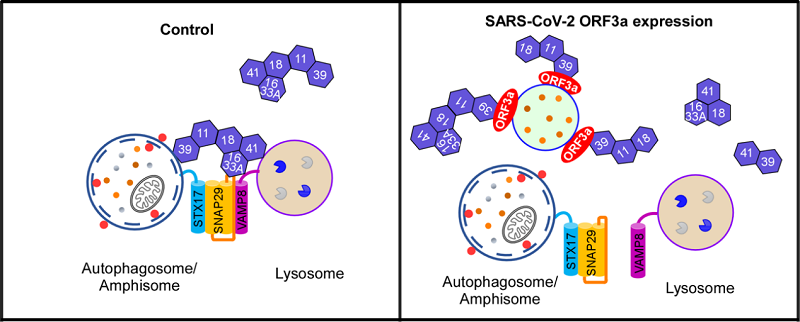Research Reveals ORF3a of the COVID-19 virus SARS-CoV-2 blocks HOPS complex-mediated assembly of the SNARE complex required for autolysosome formation
Autophagy, a process referring to sequestration of a portion of the cytoplasm in a double-membrane autophagosome and its delivery to lysosomes for degradation, acts as an important cellular mechanism to combat diverse detrimental stresses such as starvation, energy deprivation, and pathogen invasion. Viruses have evolved various strategies to block autophagy and even subvert it for their replication and release. It
It remains unknown how the endomembrane system is remodeled and the autophagy pathway is modulated in SARS-CoV-2-infected cells. Led by Prof. ZHANG Hong, researchers from the Institute of Biophysics of Chinese Academy of Sciences (CAS) revealed that SARS-CoV-2 ORF3a blocks autophagy. This paper entitled "ORF3a of the COVID-19 virus SARS-CoV-2 blocks HOPS complex-mediated assembly of the SNARE complex required for autolysosome formation" was published in Developmental Cell online on December 16, 2020.
Researchers demonstrated that ORF3a of the COVID-19 virus SARS-CoV-2 inhibits autophagy activity by blocking fusion of autophagosomes/amphisomes with lysosomes. The late endosome-localized ORF3a directly interacts with and sequestrates the HOPS component VPS39, thereby preventing HOPS complex from interacting with the autophagosomal SNARE protein STX17. This blocks assembly of the STX17-SNAP29-VAMP8 SNARE complex, which mediates autophagosome/amphisome fusion with lysosomes. Expression of ORF3a also damages lysosomes and impairs their function. SARS-CoV-2 virus infection also blocks autophagy, resulting in accumulation of autophagosomes/amphisomes, and causes late endosomal sequestration of VPS39. Surprisingly, ORF3a from the SARS virus SARS-CoV fails to interact with HOPS or block autophagy.
In summary, this study revealed a mechanism by which SARS-CoV-2 evades lysosomal destruction and provides insights for developing new strategies to treat COVID-19.

Figure. A model showing that SARS-CoV-2 ORF3a blocks HOPS complex-mediated assembly of the SNARE complex required for autolysosome formation.
(Image by Dr. ZHANG Hong's group)
Corresponding author of this paper is ZHANG Hong, and the associate professor MIAO Guangyan of the Institute of Biophysics, CAS is the first author of this paper. This research was supported by the National Natural Science Foundation of China, the Chinese Ministry of Science and Technology, the Beijing Municipal Science and Technology Committee, the Strategic Priority Research Program of the Chinese Academy of Sciences (CAS) and the Key Research Program of Frontier Sciences, CAS.
Article link: https://www.cell.com/developmental-cell/fulltext/S1534-5807(20)31016-9
Contact: ZHANG Hong
Institute of Biophysics, Chinese Academy of Sciences
Beijing 100101, China
Email: hongzhang@ibp.ac.cn
(Reported by Dr. ZHANG Hong's group)

